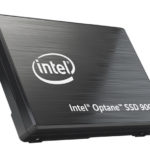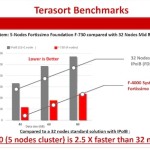BOISE, Idaho, March 16, 2021 — Micron Technology, Inc. (Nasdaq: MU), today announced updates to the company’s portfolio strategy to focus on memory and storage for the data center. Micron will increase investment in new memory products that leverage the Compute Express Link (CXL), the recently introduced industry standard interface that enables flexible connection between […]
Micron Updates Memory and Storage Strategy – Commits to CXL, Ends Development of 3D XPoint
Now Shipping: Intel Optane SSDs with 4x Performance of NAND-Based Devices
Today Intel announced the launch of the Intel Optane SSD 900P Series, the first SSD for desktop PC and workstation users built on Intel Optane technology. “Up to four times faster than competitive NAND-based SSDs, the Intel Optane SSD 900P Series delivers incredibly low latency and best-in-class random read and write performance. The Intel Optane SSD 900P Series is ideal for the most demanding storage workloads, including 3D rendering, complex simulations, fast game load times and more. The device also offers up to 22 times more endurance than other drives.”
Eric Barton Joins DDN as CTO for Software-Defined Storage
Today DDN appointed Eric Barton as the company’s chief technology officer for software-defined storage. In this role, Barton will lead the company’s strategic roadmap, technology architecture and product design for DDN’s newly created Infinite Memory Engine business unit. Barton brings with him more than 30 years of technology innovation, entrepreneurship and expertise in networking, distributed systems and storage software.
Intel Rolls Out First Optane SSD with 3D XPoint Technology
“Delivering an industry-leading combination of low latency, ultra endurance, high QoS, and high throughput, the Intel Optane SSD DC P4800X Series is the most responsive data center SSD. Built with the revolutionary new 3D XPoint memory media, the SSD DC P4800X is the first product to combine the attributes of memory and storage. This innovative solution is optimized to break through storage bottlenecks by providing a new data tier.”
SAGE Project Looks to Percipient Storage for Exascale
“The SAGE project, which incorporates research and innovation in hardware and enabling software, will significantly improve the performance of data I/O and enable computation and analysis to be performed more locally to data wherever it resides in the architecture, drastically minimizing data movements between compute and data storage infrastructures. With a seamless view of data throughout the platform, incorporating multiple tiers of storage from memory to disk to long-term archive, it will enable API’s and programming models to easily use such a platform to efficiently utilize the most appropriate data analytics techniques suited to the problem space.”
Superior Performance Commits Kyoto University to CPUs Over GPUs
In this special guest feature, Rob Farber writes that a study done by Kyoto University Graduate School of Medicine shows that code modernization can help Intel Xeon processors outperform GPUs on machine learning code. “The Kyoto results demonstrate that modern multicore processing technology now matches or exceeds GPU machine-learning performance, but equivalently optimized software is required to perform a fair benchmark comparison. For historical reasons, many software packages like Theano lacked optimized multicore code as all the open source effort had been put into optimizing the GPU code paths.”
Podcast: Intel Scalable System Framework Moves HPC Forward at the System Level
In this Intel Chip Chat podcast, Alyson Klein and Charlie Wuischpard describe Intel’s investment to break down walls to HPC adoption and move innovation forward by thinking at a system level. “Charlie discusses the announcement of the Intel Xeon Phi processor, which is a foundational element of Intel Scalable System Framework (Intel SSF), as well as Intel Omni-Path Fabric. Charlie also explains that these enhancements will make supercomputing faster, more reliable, and increase efficient power consumption; Intel has achieved this by combining the capabilities of various technologies and optimizing ways for them to work together.”
Podcast: Micron’s Steve Pawlowski on the Latest Memory Trends for HPC
In this podcast from ISC 2016 in Frankfurt, Steve Pawlowski from Micron discusses the latest memory technology trends for high performance computing. “When you look at a technology like 3D XPoint and some of the new materials the industry is looking at, those latencies are becoming more DRAM-like, which makes them a more attractive option to look at. Is there a way we can actually inject persistent memory that’s fairly high-performance so we don’t take a performance hit but we can certainly increase the capacity on a cost-per-bit basis versus what we have today?”
A3Cube Announces Exa-Converged Parallel Systems
Today Italy’s A3Cube announced the F-730 Family of EXA-Converged parallel systems built on Dell servers and achieving sub-microsecond latency through bare metal data access. “A3Cube’s EXA-Converged infrastructure represents the next step in the evolution of converged systems”, said Emilio Billi, A3Cube’s CTO, “while keeping and improving on the scalability and resilience of Hyper-Converged infrastructure. It is engineered to converge all system resources and provide parallel data access and inter node communication at the bare metal level, eliminating the need for, and the limits of, traditional Hyper-converged systems. The system can efficiently use all the fastest storage devices currently on the market or planned to come to market, and puts all existing solutions in the rear view mirror.”











